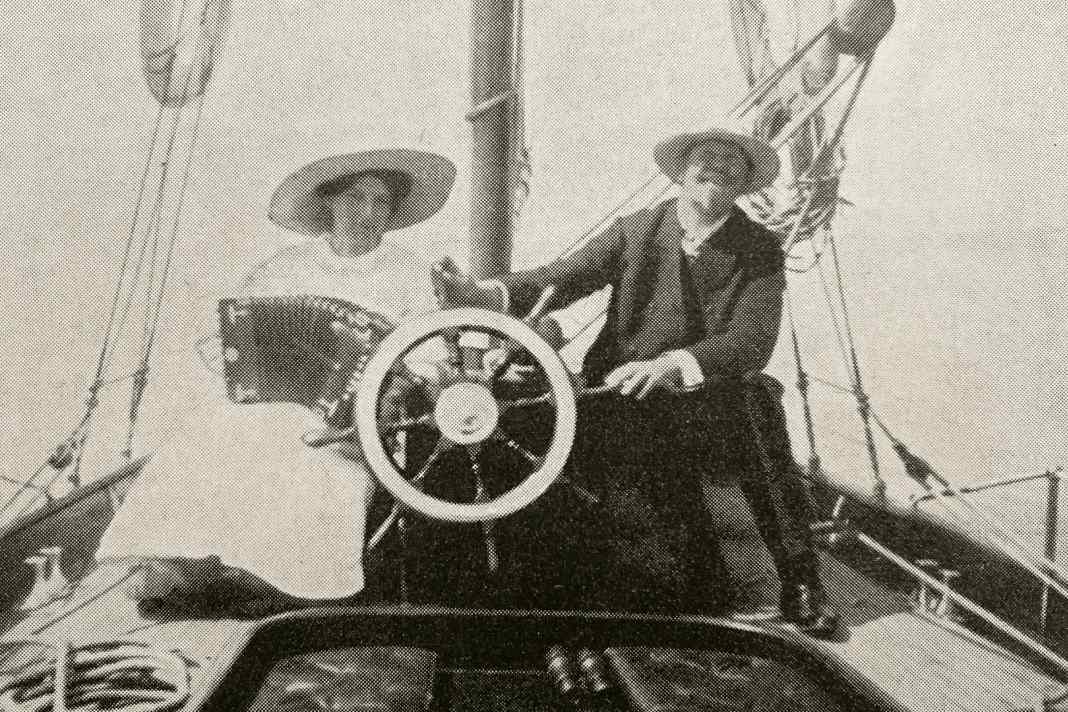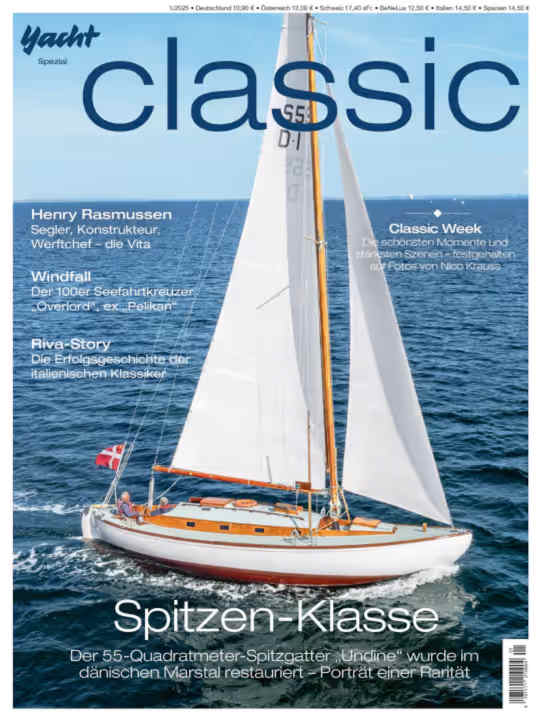


They only ventured on board when it was "lady wind" - WS 0-2 - armed with parasols and fillet half-gloves for fear of freckles. They thought it was "heavenly", at least until the engagement was perfect. After that, however, it was: "Isn't that right, darling, now I don't need to go on that 'dreadful' sailing ship anymore?" That's what happened in my home port of Wannsee in 1879, a prehistoric time when not only I myself but also the sport of sailing in Berlin was still in its nappies.
Also interesting:
However, the sailors' wives of the time protected the sport in their own way by embroidering the names of the boats in huge letters on metre-long flags (they called them "flags"), which then fluttered from the gaff's nock during the race as a business card that could be read from afar, making a programme superfluous. After the regatta, the most prominent wife presented the prizes to the winners with a gracious smile. These were usually breakfast baskets. They also promoted the sport by providing the necessary provisions.
Progress and initial exceptions
This was still the case in 1895, when the Kiel Canal was opened with a glittering Kiel Week, for which the North German Regatta Association had chartered the saloon steamer "Peregrine" as a hotel ship for its members. On board were the crème de la crème of Hamburg society, including the ladies of the Wentzel family. One of them was the young married Mrs Richard Krogmann. The Hamburg ladies were very interested in the regatta, but of course only from the escort steamer. Sailing along? Unthinkable!
There was only one exception, she was from Hanover, the wife of Admiral a. D. Rittmeyer. She steered better than her husband and beat my father on his "Luna", which later became so famous. It was actually illegal for a lady to be at the helm during a race, as the German clubs did not accept female members, with the exception of the oldest club, the Königsberg "Rhe". It is said that there were already women sailing there at the time.
Of course, all club festivities were also exclusively male affairs. When the Imperial Yacht Club went on a squadron trip to Eckernförde followed by a meal, the ladies who came along had to eat for themselves at a cat table in a semi-dark anteroom. At the same time, there was a boat that belonged to a woman at the top of the club's yacht list: the "Iduna" of the German Empress. She sometimes sailed on it and was the godmother of the daughters of her sailing officer v. Karpf.
From 1908 onwards, the Seglerhaus am Wannsee club organised internal races for its ladies. However, this was a harmless affair in which the male prompters did their best. But the development was unstoppable.
Women on board and social change
On many sea-going cruisers, ladies were already part of the crew, albeit in the modest position of a smutje. Cooking on board was not quite as comfortable as at home when the hatches were tight, the boat rolled and lurched, the soup ran out of the pot and the Primus stank more than it burnt despite all the pumping. Some wives thought this was no fun and stayed at home. But because most men were reluctant to do without female company, it happened that in remote harbours you would meet a good acquaintance accompanied by a "Fräulein Gemahlin". Indeed, this was so common that in Scandinavia I was occasionally mistaken for my captain's relation. When, in response to such a suggestion, he would say: "Allow me! That's my wife!", people laughed cosily: "Oh, the Germans always say that!"
That changed when, after the First World War, we not only got the right to vote, a bobbed head and sailing trousers, but also gradually became members of most sailing clubs. We finally had equal rights on the water!
Modern female sailors achieve regatta successes
The most famous sailor of the post-war period was a French woman, Madame Hériot, who travelled from one European regatta venue to another throughout the year and won all the big prizes. She had bought the Emperor's last "Meteor" as her home and furnished it beautifully. During the regattas in Sandhamn, a special aeroplane from Stockholm brought her fresh flowers every day to decorate her rooms. She herself, although very rich, was extremely simple and thought of nothing but sailing. A young Miss Hovey came from America with an American team to a German-American international competition; she was the best rower on her team.
In Germany, too, capable female racing sailors grew up, including the likeable Mrs Müller, Steinhude, who won the Hamburg Senate Prize with her national dinghy "Meerkatze" against the toughest competition. The young Annemarie Graßmann with her skerry cruisers "Swonk" and "Helios" had good success over the years. The pictures of these well-known racing greats went through all the illustrated papers, and as a reporter I made sure of that out of female solidarity.
Unrecognised heroines of sailing
Unnoticed by the public, there were also enthusiastic female sailors on their larger or smaller cruisers. These were mostly women who had been denied a husband and children by fate and who found a substitute in their beloved boat. But what does such a little lady's boat look like? A jewellery box inside and out, because most of the owners caulk and fill, paint and varnish themselves, because no one else does it carefully enough for them. They don't make a fuss, but there are more of them than you might think, and every club can be proud of these members.
Sailing women! Can you imagine a club, a jetty or a party today without these cheerful, colourful characters? Excellent rowers, foresheet men and smutjes are among them, both inland and at sea. But sadly, one day you won't see the enthusiastic sailor anymore. Why? Because "he" - the man, the captain - has given up the sport for some reason. Let them go! They are the descendants of the "female sailors" of 1879, but a new generation is already growing up. I heard a young girl say the other day - driving licence, although only 16, but sailing blood in the fourth generation: "I'll only marry someone who sails, because I want to stick with it!"
Sailing sports reporter Käthe Bruns: Pioneer at the tiller and feather
Born in Berlin (1879-1970), she grew up on Wannsee as the daughter of an enthusiastic sailor, spent every spare minute on the water and experienced the beginnings of the sport at first hand. She married a founding member of the Berlin ASV and sailed challenging voyages with him. After his death in 1928, Bruns became the first German female sailing reporter and wrote for YACHT for many years. Bruns sailed until the end of her life.

The review "Damensegeln" has been published in the current issue of YACHT classic, which has been on sale since 21 May (available here). YACHT subscribers get the magazine delivered to their door for free. You can also read the portrait of shipyard founder Henry Rasmussen, the history of the "Nordwest" and look back on Classic Week 2024 in photos by Nico Krauss.

